 |
|
|
Translate this page in your preferred language:
|
| HEALTH : |
| Back |
Health :
It is a state of freedom from disease. It may also be stated as a condition of an animal in which all the body organs are normal and are functioning to their optimum capacity in relation to animal’s age, sex, work, and production with optimum pulse, temperature and respiration rates appropriate to the species, sex and environment.
Disease :
Disease may be any deterioration from normal health or normal functioning of any or all the tissues or organs of animal body. Thus, it shuns animal to perform its normal physiological functions though the nutritional and environmental parameters are maintained normal.
SIGNS OF HEALTHY ANIMAL:
 |
| Healthy Cow |
- Wet muzzle.
- Shining skin and eyes.
- Rosette pink mucous membranes.
- Normal rumination (Ruminal movements: 3 per 2.5 minutes).
- Normal gait and eating behavior
- Urination and defecation normal.
- Well kept head
- No abnormal discharge from any natural orifice
- No abnormality in milk and milk composition
SIGNS OF ILLNESS IN ANIMALS
 |
| Sick Cow |
- General posture of animals, its behavior, movements and expressions change.
- Animal show dull dejected appearance and stands in isolation with head downwards.
- Loss of appetite and cessation of ruminal movements.
- Skin becomes dry, hair coat becomes dull, and hair may become brittle and fall off.
- Muzzle becomes dry.
- Sunken, glued eyes, staring look, discharge from eyes.
- Any abnormal discharge from natural orifices, pus from the organ involved shows septic changes.
- Blood or dark colored urine with repulsive odor.
- Change in color and consistency of feces.
- Change in quality and quantity of milk production.
- Change in voice of animal i.e. grunting, groaning or grinding of teeth by animal shows that animal is in pain.
- Nervous signs, edema of any body part, abnormal gait, inflammatory conditions.
- Change in respiration, body temperature, and pulse rate. Normal data is given as:
|
S.No |
Species |
Body temperature (°F) |
Pulse rate (per minute) |
Respiration rate (per minute) |
|
1. |
Cattle :
1. Calf
2. Adult
|
101.3-104.4
101.5
|
90-120
50-60
|
27-50
20-25
|
|
2. |
Buffalo |
98.3 (winter)
103 (summer)
|
40-50 |
15-20 |
MAJOR DISEASES OF CATTLE AND BUFFALO AND ITS MANAGEMENT:
The important infectious diseases of the cattle and its control are:
INFECTIOUS DISEASES :
------------------------------------------------------------------------------------------------------------
Foot and mouth disease:
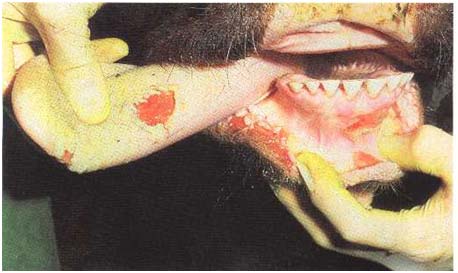 |
|
 |
| Foot & Mouth Diseases |
Cause
The disease is caused by a virus Picornavirus of which there are seven ‘types’, each producing the same symptoms, and distinguishable only in the laboratory. Immunity to one type does not protect an animal against other types.
The interval between exposure to infection and the appearance of symptoms varies between twenty-four hours and ten days, or even longer. The average time, under natural conditions, is three to six days.
Symptoms
- Fever
- Bilsters in the mouth and on feet
- Drop in milk production
- Weight loss
- Loss of appetite
- Quivering lips and frothing of mouth
- Cows may develop blisters on teats
- Lameness
Treatment
Treatment is not given. Affected animals will recover. However because of the loss of production and the infectious state of the disease, infected animals are usually culled.
Management
1. Forcibly feed the animals as due to blisters in mouth they may not be able to eat.
2. Use of potassium permanganate solution for lavaging the wounds due to the disease and antiseptic dressing thereafter by using povidone iodine.
Prevention
FMD is one of the most difficult animal infections to control. Because the disease occurs in many parts of the world, there is always a chance of its accidental introduction into an unaffected country.
Export restrictions are often imposed on countries with known outbreaks.
FMD outbreaks are usually controlled by quarantines and movement restrictions, euthanasia of affected and in-contact animals, and cleansing and disinfection of affected premises, equipment and vehicles.
Infected carcasses must be disposed of safely by incineration, rendering, burial or other techniques. Milk from infected cows can be inactivated by heating to 100°C (212°F) for more than 20 minutes. Slurry can be heated to 67°C (153°F) for three minutes.
Rodents and other vectors may be killed to prevent them from mechanically disseminating the virus.
Good biosecurity measures should be practiced on uninfected farms to prevent entry of the virus.
Vaccination
Vaccination can be used to reduce the spread of FMD or protect specific animals.
Vaccines are also used in endemic regions to protect animals from clinical disease. FMDV vaccines must closely match the serotype and strain of the infecting strain.
Vaccination with one serotype does not protect the animal against other serotypes, and may not protect the animal completely or at all from other strains of the same serotype. Currently, there is no universal FMD vaccine.
Black Quarter:
- Black Quarter is one of the deadly bacterial diseases of cattle.
- The disease spreads rapidly after heavy rainfall by contamination of soil with spores of the organism.
- Treatment of the disease with specific antibiotic is useful if the diagnosis of the disease can be made at the early stage.
The disease can be controlled by regular vaccination
| Vaccine |
Age |
Dose |
Booster |
Interval |
Season |
Polyvalent
B.Q.
Vaccine |
All age |
5 ml s/c |
6 months |
Annual |
Before onset of
monsoon, all season
in endemic areas |
Haemorrhagic septicaemia (HS):
 |
| Hemorrhagic Septicemia |
- The incidence of H.S. is throughout the year.
- The outbreak is not only in the period of high humidity or monsoon but also in winter season.
- Highest number of outbreaks during high humid and rainy season as compare to winter season.
- Although antibiotics are available for the treatment, there may not be any time for treatment in most cases.
The disease may be controlled by regular vaccination.
| Vaccine |
Age |
Dose |
Booster |
Interval |
Season |
H.S.
adjuvant
vaccine |
All ages |
3 ml i/m |
6 months |
Annual |
Preferably in
May/June |
ZOONOTIC DISEASES :
------------------------------------------------------------------------------------------------------------
Brucellosis:
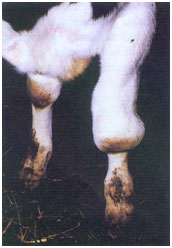 |
| Brucellosis |
- There is no seasonal variation for occurrence of the disease.
- Regular screening of serum samples for detection of the disease is required.
- Incidence of brucellosis can be reduced by elimination of infected bull, isolation and treatment of positive reactors and
calfhood vaccination.
- Brucella is one of the world’s major zoonotic pathogens, and is responsible for enormous economic losses as well as considerable human morbidity in endemic areas.
How to diagnose?
Diagnosis can only be confirmed by laboratory tests. The RBPT, tube agglutination and ELISA procedures are recommended.
Treatment:
Treatment for brucellosis in animals is neither advisable nor practicable.
In humans:
Treatment of uncomplicated cases in adults and children eight years of age and older: doxycycline 100 mg twice a day for six weeks + streptomycin 1 g daily for two to three weeks.
OR
Doxycycline 100 mg twice a day for six weeks + rifampicin 600–900 mg daily for six weeks.
Control and Prevention:
- Animal brucellosis is best prevented by careful herd management and hygiene.
- Vaccination is useful for prevention and control of infection.
- B. abortus strains 19 and RB 51 are recommended for prevention of bovine brucellosis.
- B. melitensis Rev 1 is recommended for prevention of B. melitensis infection in sheep and goats.
- Control and prevention schemes require effective collaboration between all sections of the community.
- Education and information programmes are essential to ensure cooperation at all levels in the community.
- Effective preventive measures and control of animal movements are essential.
Anthrax: (Bacillus anthracis)
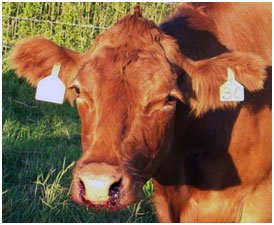
Animal affected: Cattle, buffalo, sheep, goat, pig.
Symptoms/lesions: High fever (105o-106oF), oedematous swelling of the neck and throat, loss of appetite, difficult respiration, sudden death is also common, After death, bleeding from natural orifices.
Treatment/Control: Keep the affected animal away from others. Annual vaccination recommended before the onset of rains.
Tuberculosis: (Mycobacterium species)
Animal affected: Cattle, buffalo, sheep, goat, pig.
Symptoms/lesions: Irregular low-grade fever of long duration, coughing, difficulty in respiration, anaemia, progressive emaciation and loss of body weight.
Treatment/Control: Consult veterinary doctor for the confirmation of diagnosis and get your animals tested with tuberculin.
Pseudo Cow-pox
 |
|
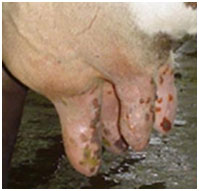 |
| Pseudo Cow-pox |
Animal affected: Milking cows
Symptoms/lesions: Slight fever, teats become swollen and warmer. Congested area and vehicles appear on teat and udder. After few days the vehicles contain pus and finally dry crusts are formed. In male animals the virus affects scrotum.
Treatment/Control: Apply milk and soothing disinfectants.
PRODUCTION DISEASES :
------------------------------------------------------------------------------------------------------------
Mastitis:
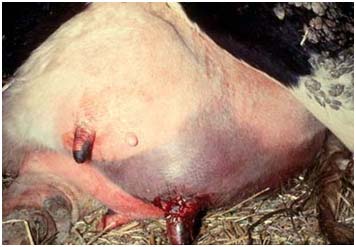 |
|
 |
| Gangrenous Mastitis |
|
Mastitis |
- Mastitis or inflammation of mammary gland or udder is an economically important condition in milking animals.
- It may affect one or all quarters of the udder.
- It is manifested in the form of swelling of the affected quarters, change in milk color and composition.
How to diagnose?
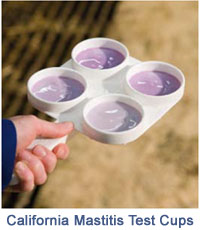
- Clinical signs, palpation of udder, monitoring the milk consistency may give clue about causation of mastitis.
- Subclinical cases may go unnoticed and therefore testing of milk with California mastitis test (CMT) or any other spot test is necessary.
Impact of the problem:
- If one quarter is affected by mastitis, 25% milk yield is lost permanently.
- It may also spread to other quarters; hence it causes major economic losses to the farmer.
- High yielding animals are more prone to this condition, if not milked properly.
Treatment:
a. Udder infusion: Disposable tubes with water soluble ointment base need to be used. Emptying of udder is essential before infusion.
b. Parental treatment is advisable. Before antibiotic therapy, the sensitivity of the pathogens to particular antibiotics should be carried out.
c. Iodophors are important teat dips. Application of preparations containing 3000-5000 mg. available iodine per kg, depending on the glycerin concentration, leads to reduction in bacterial numbers.
d. Culling of cows with therapy resistant udder diseases.
e. If machine milking is practiced then rinsing of the teat cups and dipping them in the disinfectant wash water between cows, by
dipping a pair of each cluster in turn or hot water (170°-180°) for 10 sec. is effective.
Control and Prevention:
- Mastitis control must be concentrated on the prevention aspects, which depend mainly on the whole hygienic management and absence of stress conditions.
- Young animals should be milked before older.
- Newly introduced animal should milked separately.
- Specific control measures need to be taken according to the respective cause and the extent of losses. Specific control measures include:
- Correction of milking technique.
- Teat disinfection (e.g. teat dipping) following milking.
- Antibiotic treatment at drying off.
- Culling of animals with therapy - resistant mastitis.
Milk Fever:
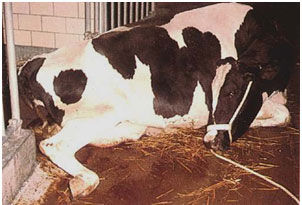 |
| Milk Fever |
- Milk fever is a common metabolic disorder in dairy cattle that generally affects older, high producing cows.
- It may also be referred to as parturient paresis or hypocalcaemia.
- The majority of milk fever cases occur within 48 to 72 hours of calving when demand for calcium for milk production exceeds the body’s ability to mobilize calcium reserves.
- Fever is a misnomer as body temperature is usually below normal.
- Low blood calcium interferes with muscle function throughout the body causing general weakness, loss of appetite and eventually heart failure.
Signs of Milk Fever:
- At first, cow experiences muscle tremors, lack of appetite, and unsteadiness.
- Eventually, cow is unable to rise, body temperature falls, and constipation occurs.
- Cows go down to a sitting position often with a kink in her neck.
- Death can occur if the cow is not treated promptly.
Prevention of Milk Fever:
- Management of the diet can be a valuable aid in preventing milk fever.
- The key to prevention of milk fever is management of a close-up dry cow which should be kept on a low calcium diet.
- When the demand for calcium increases at calving, calcium can be mobilized much more rapidly thus preventing milk fever.
- Lucerne, a feed high in calcium and potassium, should not be a major ingredient in close-up dry cows’ diets.
- In early lactation, high yielding cows should receive as much calcium as possible.
- High risk cows can be injected with Vitamin D3 2-8 days prior to calving.
- Diets providing less than 15gcalcium/cow/day and fed for at least 10 days before calving will reduce the incidence of milk fever.
Ketosis:
- Ketosis, or acetonaemia, is a metabolic disorder in cattle associated with an inadequate supply of the nutrients necessary for the normal carbohydrate and fat metabolism that is seen mainly in times of high milk production in early lactation.
- Ketosis affects high producing cows during the first 6-8 weeks of lactation when cows are in negative energy balance.
- The excessive ketone bodies in the bloodstream come from the breakdown of fat when the animal is forced to draw on its bodily reserves for energy.
- The excess ketone bodies are eliminated in the urine, milk and breath of the animal.
Predisposing factors:
- Cows of any age may be affected but the disease appears more common in later lactations peaking at about the 4th lactation.
- Over conditioning at calving has been associated with increased incidence of ketosis.
- A reduction in the production of propionic acid, the main precursor of glucose in ruminants, will result in hypoglycaemia. Hypoglycaemia leads to a mobilization of free fatty acids and glycerol from the fat stores.
Clinical signs of Ketosis:
- The clinical signs of ketosis include lack of appetite (refusal to eat even concentrates) and a sudden drop in milk output.
- There is a sweet smell of acetone in the urine, breath and milk.
- Cows will have raised blood ketone levels and may excrete ketones in urine and milk.
- There is a gradual loss of body condition over several days or even weeks.
Prevention of Ketosis:
It may be prevented by management strategies that maintain a good appetite and supply adequate feed to meet this appetite during the late dry period and immediately after calving. These strategies include;
- Avoid sudden changes in feed type to newly calved animals.
- Ensure that any health problems that may cause reduced feed intake are treated as early as possible.
MANGEMENTAL DISEASES :
------------------------------------------------------------------------------------------------------
Acidosis:
Acidosis is a syndrome related to a fermentative disorder of the rumen resulting in overproduction of acid resulting in lowering of rumen pH below pH 5.5.
- The problem is related to feeding management, where the ration has high levels digestible carbohydrates and low effective fiber.
- Acidosis commonly occurs when switching from a high fiber to high concentrate diet (that is rich in fermentable carbohydrates (starches and sugars).
- Lactic acid is about ten times a stronger acid than the other rumen acids and causes the rumen pH to decrease. As the rumen pH drops below 6.0, bacteria that digest fiber begin to die depressing fiber digestion.
Causes of Acidosis:
- Diets very high in readily fermentable carbohydrates and low in roughage.
- Very fast switch from high forage to high concentrate.
- Excessive particle size reduction by feeding finely chopped forage.
Signs of Acidosis:
- Low milk fat test (one of the end products of fiber digestion (acetate) is a precursor of milk fat synthesis).
- Diarrhea (Accumulation of acid causes an influx of water from the tissues into the gut resulting in diarrhea. The feces are foamy with gas bubbles. There is an appearance of mucin/fibrin casts in feces).
Sore hooves-laminitis:
- Endo-toxins resulting from high acid production in the rumen also affect blood capillaries in the hoof, causing them to constrict resulting in laminitis.
Prevention Sore hooves-laminitis:
- Good management practices are needed to prevent the predisposing situations from occurring.
- Buffers can also be used to prevent drop in rumen pH when high concentrate diets are fed.
- Ensuring presence of effective fiber in the diet promotes production of saliva which is a buffer.
Bloat:

Bloat is the abnormal accumulation of gas in the rumen. There are three categories of bloat:
a. Frothy bloat which occurs when diets that lead to the formation of a stable froth or foam in the rumen are fed.
b. Free gas bloat caused by diets that lead to excessive gas production
c. Free gas bloat caused by failure to eructate rumen gases leading to accumulation (e.g. esophageal obstruction).
Predisposing factors:
- Bloat is a risk when animals are grazing young, lush pasture, particularly if the pasture has high legume content (clover or lucerne).
- Ruminant animals produce large volumes of gas during the normal process of digestion which is either belched or passes through the gastrointestinal tract.
If anything interferes with the gas escape from the rumen, bloat occurs.
- Natural foaming agents in legumes and some rapidly growing grasses cause a stable foam to form in the rumen.
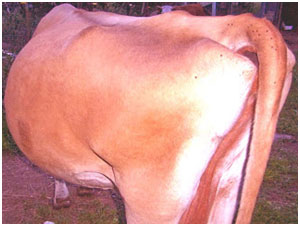 |
| Bloat |
Signs of Bloat:
- Animal stops grazing and is reluctant to walk.
- The left side of abdomen is distended.
- The animal strains to urinate and defecate.
- Rapid breathing — mouth may be open with tongue protruding.
- Staggering.
Prevention of Bloat:
a. Pasture management: Legumes should be introduced into the diet gradually over several days. Avoid cows gorging on new pastures by feeding them on other feeds before letting them out to graze. Silage, hay or more mature pasture can be used to reduce the cow's appetite.
b. Preventative medication: Detergents and anti-foaming agents can be drenched prior to grazing.
c. Treatment:
A sharp knife can be used to puncture the rumen on the left side of the animal (at the farm level as an emergency).
Puncturing the rumen with the standard trocar and canula is a quickest way to release the gas which cannot be expelled with a stomach tube.

Other Diseases:
- Foot rot – caused by a break in the skin or hoof, usually between the toes, allowing bacteria to enter. Symptoms are a rapid, progressive lameness; swollen foot; and a characteristic foul odor.
Small stones lodging between the toes can also be a problem. Animals should be provided with the recommended iodine and zinc levels.
Use a footbath with copper sulfate (2%).
- Grass tetany (hypomagnesemia) – this is likely to be observed in cows grazing on lush grass pasture that is high in nitrogen, resulting in low absorption of magnesium. Cows will suddenly develop tetany, walk with a stiff gait, fall, go into convulsions, and die. Cattle grazing on grass fields fertilized heavily with nitrogen should be carefully monitored and supplemented with
60gm of magnesium oxide daily during this period.
- Hardware disease- this results from a puncturing of the reticulum if a cow swallows a sharp object. The animal will have a sudden lack of appetite, a reluctance to move, and a careful gait. Respiration is frequently rapid, pulse rate is fast, and rectal temperature is 40ºC or higher. Give magnets to cows when a herd problem exists.
- Moldy feed toxicity (aflatoxins) - The fungus, Aspergillus flavus, and certain other molds, may produce toxic substances when feed grains are stored under high moisture and poor ventilation conditions. Death in adult animals is rare. Feeds suspected to be contaminated should be tested in a laboratory.
- Poisonous plants - Several hundred plants are known to be toxic to livestock under certain conditions.
Bracken fern, algae, and nightshade are common poisonous plants. Cattle will eat whatever is available when feed is scarce, and consuming enough of a toxic plant can have toxic or fatal effects.
- Udder edema - Edema is an excessive accumulation of fluid in the udder under the skin.
This condition usually occurs at calving and is more severe in first lactation cows. Prevention is by limiting access to either sodium or potassium salts during the dry period. Also avoid excess grain. Treatment includes stimulating circulation by massaging the udder. Diuretics (drugs that promote the formation of urine) should be used with care and direction of a veterinarian.
- Urea toxicity (ammonia toxicity) - Too much urea at one time or insufficient carbohydrate intake results in excessive ammonia in the rumen. Animals show uneasiness, muscle and skin tremors, excessive salivation, labored breathing, Inco-ordination, and bloat. Animal urinates excessively.
No more than 0.2 kg of urea should be fed per cow per day.
Animal Health Strategies:
Adequate preventive health coverage to minimize incidence of disease in livestock concentrations like milk sheds, poultry breeding areas, sheep flock, etc.
- The preventive coverage should be especially against diseases like F.M.D., Rinderpest, Haemorrhagic Septicaemia, Black Quarter, Clostridial infections, Brucellosis (wherever present).
- Efficient vaccines are available and what is needed is the systematic time bound programme of preventive vaccination, where larger coverage to susceptible population is a must to reduce the focus of infection and survival of infectious agents.
- Diseases of economic importance like Brucellosis, Tuberculosis, Johne's disease and Mastitis need to be diagnosed and suitable policy for isolation, sexual test, controlled breeding, elimination (where must), quarantine, vaccination should be adopted.
- An important disease problem arises due to parasitic infestation(s). These can be tackled by diagnosis and availability of various new generation economic anti-parasitic drugs given as per the recommendations.
- The planned health coverage against viral, bacterial, parasitic diseases can reduce health hazards, mortality and morbidity by 80% to 90% and will be able to increase productivity.
Overall health control in buffaloes:
- Buffalo should be checked daily for injuries and illnesses. Wounds and open sores are a perfect growing place for all kinds of bacteria.
It is easy to keep control over milking buffalo since they are studied closely twice a day.
- Lameness and large injuries are easier to detect than small scratches.
Lameness can be caused by injuries in the hooves and legs as well as back pains. Touch the animal carefully all over the body, to locate the injury.
- Large as well as small injuries must be taken care of. Bleeding sores may require veterinary attention although this is quite rare.
- Wounds should be carefully cleaned, and the best way is to use clean water and mild soap. Cleaning should be done very gently with clean hands and cloths. Chemicals such as ethanol and iodine might hurt.
Never attend to wounds during milking.
- Looking at the faeces is an easy way to detect internal defects. This is easy in the milking place when one pail of faeces can be related to one buffalo. If the feces look different from usual, the milker/farmer should be observant.
- Normal rectal temperature is 38º to 39ºC. If it is above that, the animal may have some sort of infection and a veterinarian should be called.
Ectoparasitic management:
The ectoparasites i.e. ticks, fleas, mites, flies, etc serve as major carrier of various life threatening diseases to dairy cows and buffaloes. Various measures which should be taken to curb the problem of ectoparasites include:
- Better housing facilities which should include filling of cracks and crevices in the walls of the animal shed, construction of pucca floor, shed should be well ventilated and lightened, the corners of the shed should be rounded, mangers and water troughs should be cleansed regularly and the water logging should be prevented.
- The surrounding should be kept clean, the litter should be dumped away from the animal shed, marshy and damp areas should not surround the animal shed.
- Treatment of animals suffering from ectoparasites should be done away from the animal sheds and milking parlor.
- Treatment of all the animals in a herd should be done at same time and at regular intervals.
- Before treating the animal with any anti-ectoparasitic drug the animal should be given enough water for drinking and the mouth of the animal should be restrained by application of muzzle.
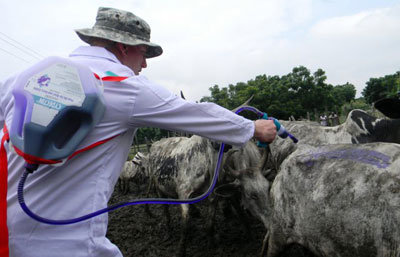 |
| Treating ectoparasites by sprays |
Treatment of ectoparasites include:
- Deltamethrin @ 2-3ml/liter of water should be used for spraying or dusting on animal body and 5ml/liter for spraying in animal shed.
- Amitraz: 2ml/liter (for spraying on animal body), and 4ml/liter (for spraying in animal shed).
- Ivermectin: 1ml for 50 kg weight of the animal through subcutaneous route.
|
|
| Back |
|
|
Developed by :
|
Jaspal Singh
(Ex. M.V.Sc Scholar ) |
Dr. Pranav Kumar
(Assistant Professor)
|
Amandeep Singh
(Final Year B.V.Sc & AH student) |
|
|
|
|
|
|
Scroll
|
Division of Veterinary and Animal Husbandry Extension Education
Faculty of Veterinary Sciences and Animal Husbandry, R.S. Pura, SKUAST Jammu |
|


















